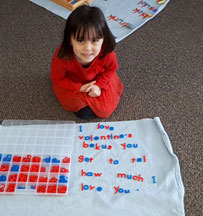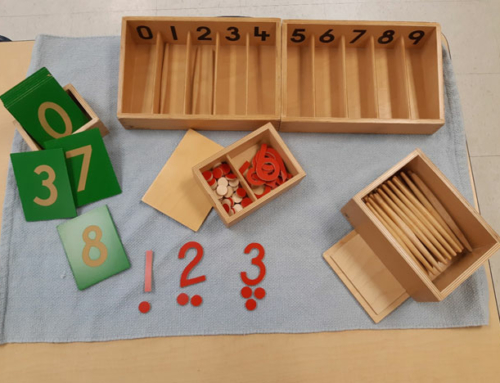Reading and writing are sometimes taken for granted by adults who have mastered the skills—but looking at them from a child’s perspective, they are skills of Herculean difficulty. Literacy is a complicated, integrative process that involves the association of symbols with sounds, sounds with words, and words with ideas. It means learning to fluidly encode ideas into symbols and decode symbols into ideas. And, on top of everything, it involves acquiring complex physical production skills, such as the fine motor skills involved in writing with a pen or pencil.
The Montessori approach uses a distinct set of practices that nurture a positive, natural learning experience to teach reading and writing. The Montessori curriculum is thoughtfully built around teaching children the many elements of reading and writing one by one, in a way accessible to and enjoyable for a child. Here are a few of the steps in the sequence used in a Montessori environment to ensure that children master literacy with joy.

Children in a Montessori environment learn to write first before they learn to read. This approach is organic, as children can put the letters for the sounds they know together into a word before they are ready to interpret and string together the sounds of a word on a page. Children begin learning the letter sounds using sandpaper letters, which incorporate the sense of touch to further reinforce learning. While the child learns the letter sound, they trace the letter with their fingers on a textured sandpaper inscription of the letter, learning the strokes used eventually to write that letter on paper.
Once a child has mastered the sounds associated with each letter, she’ll be shown the moveable alphabet, which will allow her to easily put letters together, sounding them out to spell simple, then progressively more complex, words. Children love to move and learn by doing. They learn best by physically interacting with the world, so why not take advantage of their natural tendencies to do so? The moveable alphabet allows children to begin “writing”—even before they develop the fine-motor skills to control a pencil.
Writing is a hands-on process, and the Montessori approach fully leverages the fact that children are naturally hands-on learners. In the Montessori classroom, children develop hand strength early on during activities that encourage the use of the “pincer grip”, such as the cylinder blocks. The hand position used to pick up the blocks is the same as the one used in holding a pencil!
When foundational hand strength is developed, we begin direct work with pens and pencils by introducing children to our beautiful collection of coloured pencils and the metal insets. Instead of plodding through tedious handwriting worksheets, they are
intrigued by the coloured pencils and start using them to trace shapes, draw parallel lines or make patterns. Children love to colour and create artwork, practicing a skill that they will later use to write letters and words. Through doing this, the child learns to use and control pencils while expressing herself in a creative way. When the child combines this skill with the previously mentioned ones, she joyfully discovers that she is now able to write letters on paper.

After a child has learned how to use the letter sounds to construct words, she progresses towards joining words together into sentences of her own construction, and from there, there is an explosion of writing ability and enthusiasm. After mastering the skills associated with producing written letters and words, reading naturally comes as the next step. She discovers that she is now able to see printed words on a piece of paper and decode their meaning. Children will suddenly show a new, heightened interest in the written word. By learning to read, a whole new world is opened to them. Just watch them start to read the side of a milk carton or the label on their shampoo bottle, and you will see the excitement that can come from learning this essential skill!
When teaching early reading skills, we use a beginner series of books titled The Max Series. If a child does not understand a book, they quickly become bored as they lose track of what is happening in the story. The Max Books only use vocabulary suited for beginning readers, and still tell compelling stories and have engaging illustrations that keep the child’s interest. We want the child to experience reading and writing as interesting, fun activities, not as a mechanically learned chore. These beginner books, similarly, to the coloured pencils and metal insets, are tools designed to captivate the child and help motivate him to develop these early reading and writing skills.
Teaching children to read and write at Bayside is an incredibly rewarding experience. Our teachers follow your child through these and other steps, guiding them through a process carefully designed to encourage enthusiastic producers and consumers of the written word. We take pride in growing these fundamental roots of each child’s education—the foundation that will support their learning for the rest of their lives.







